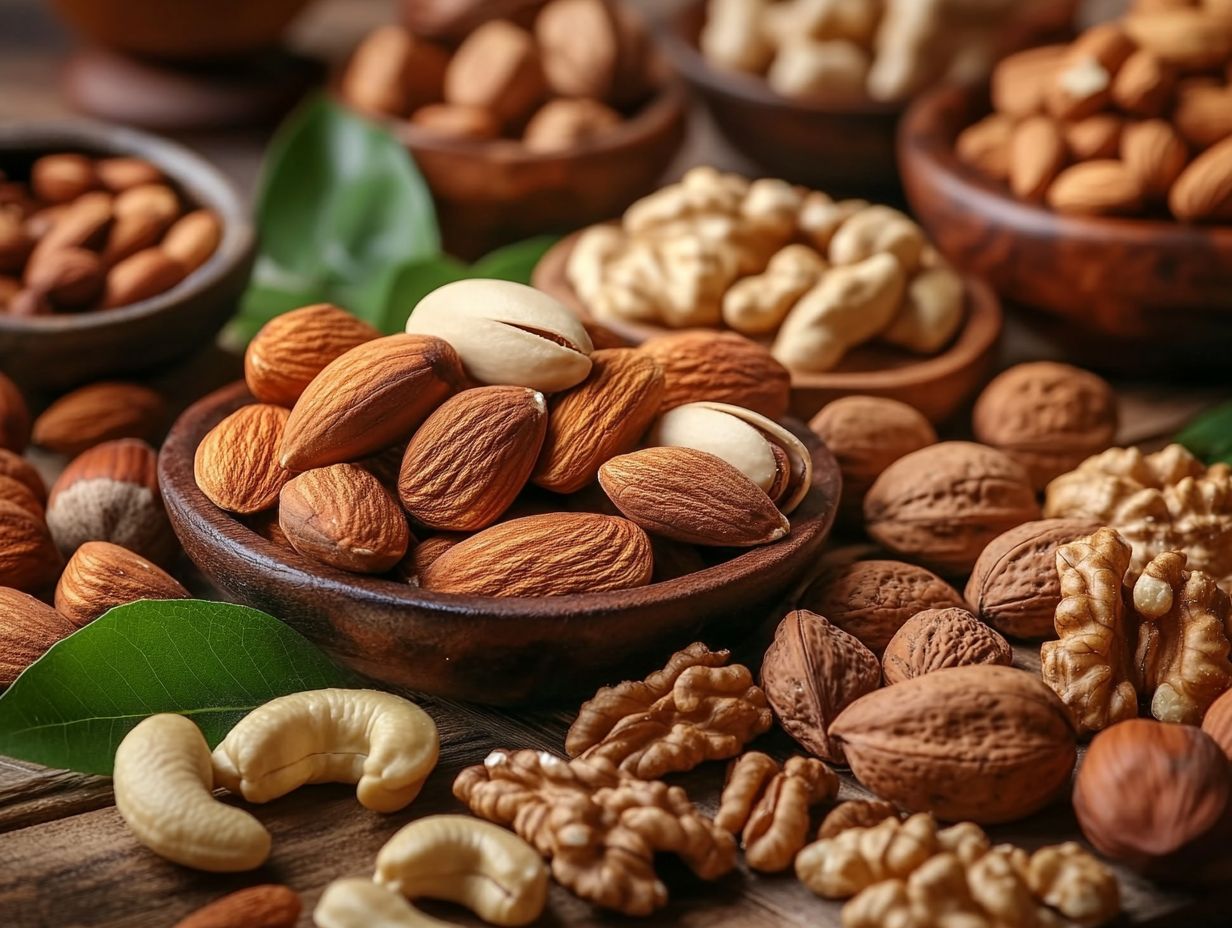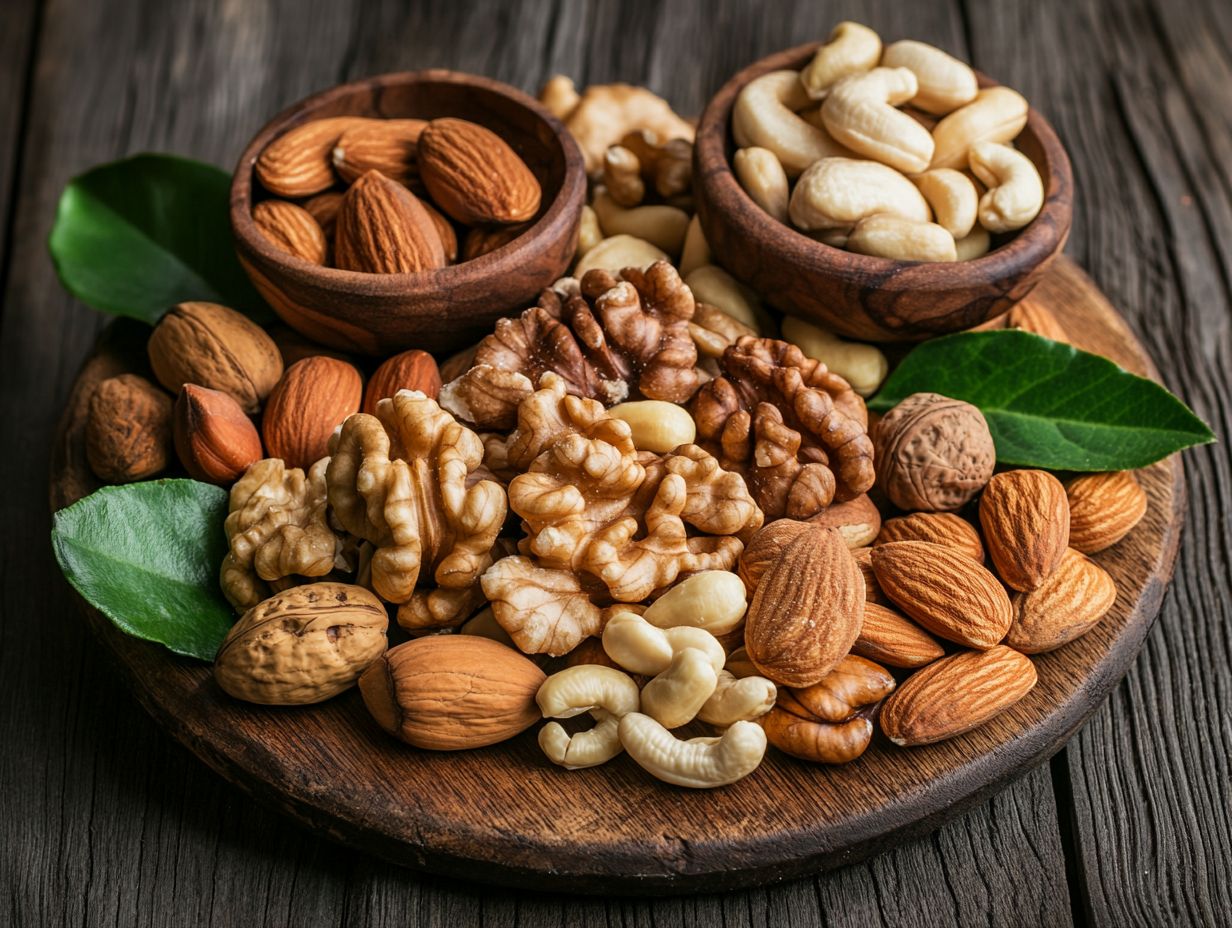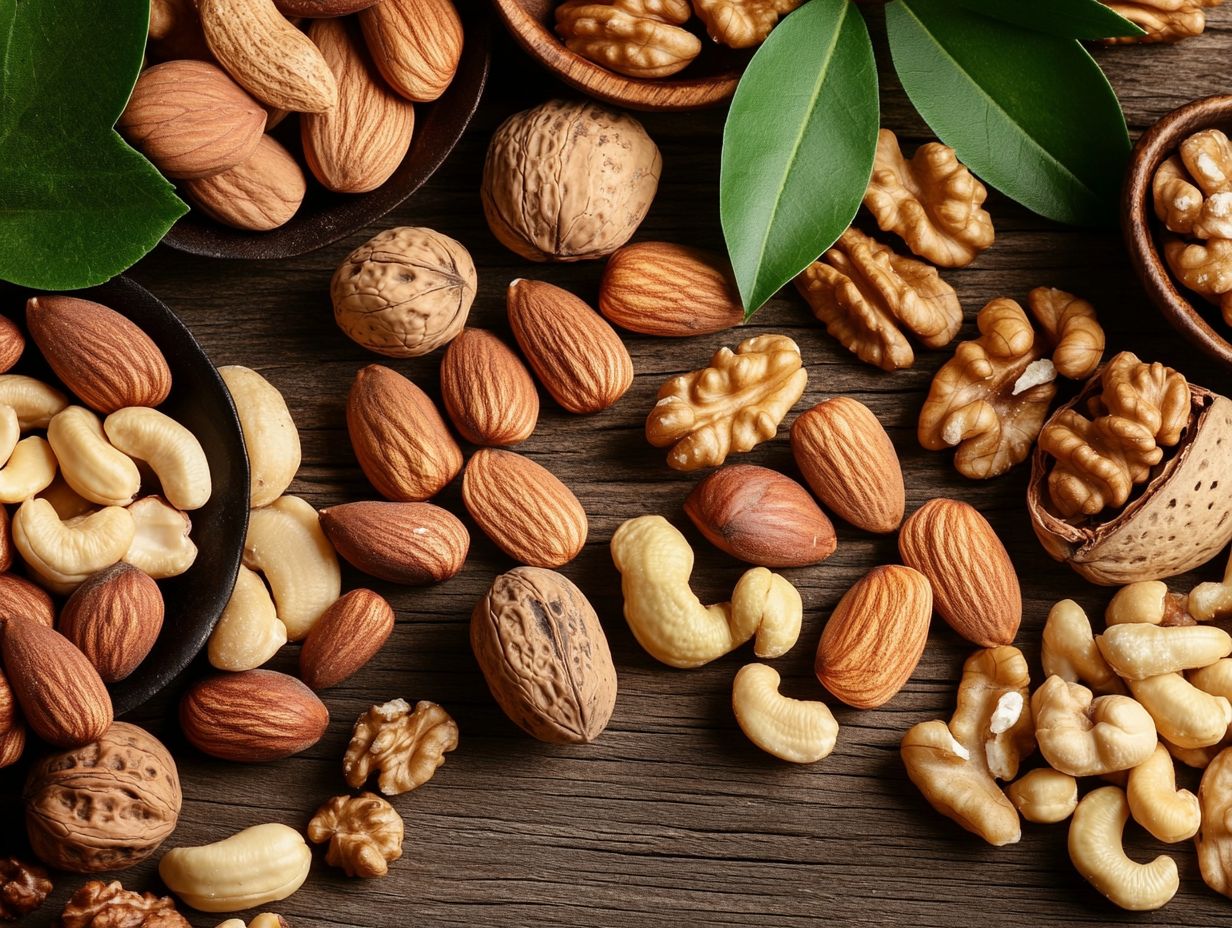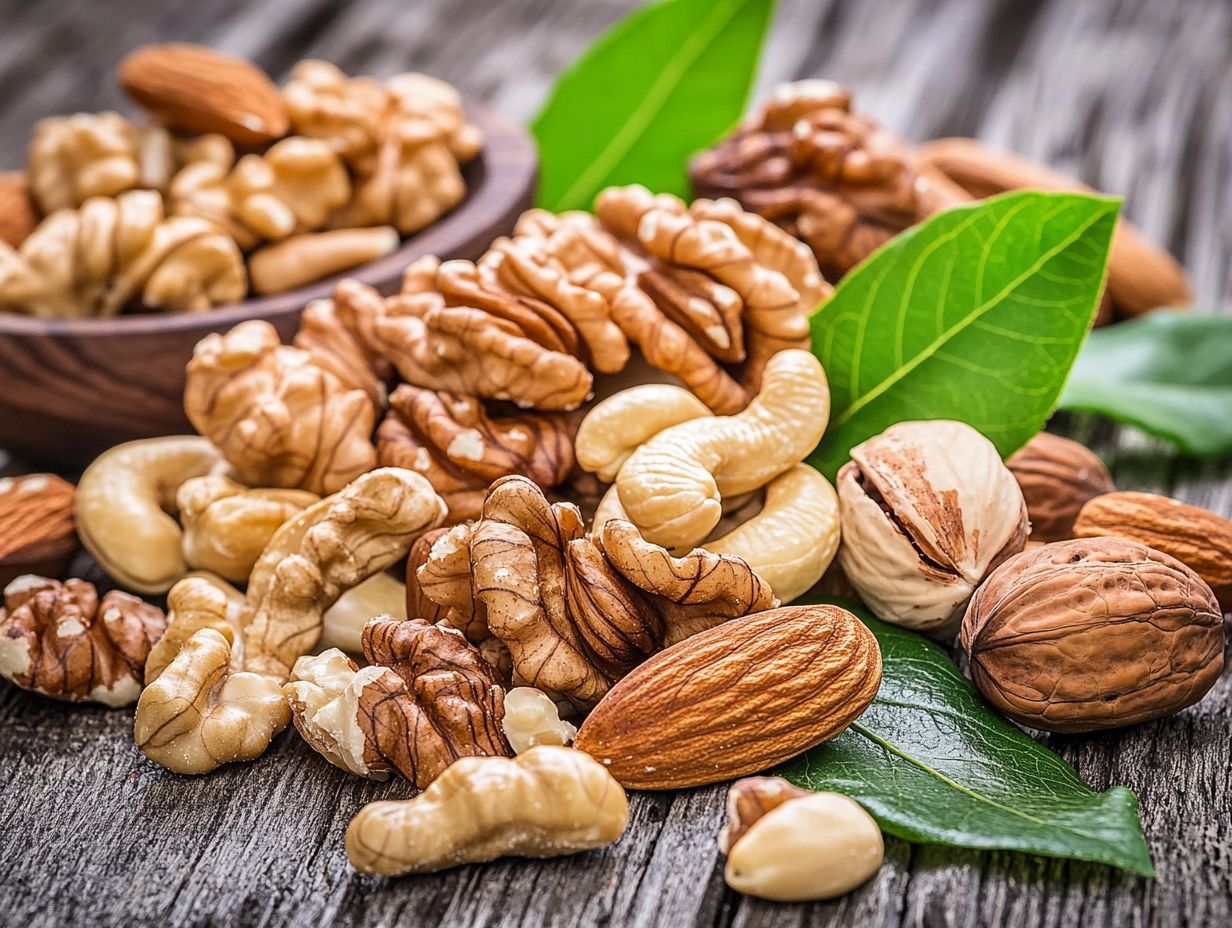How to Identify Edible Nuts?
Edible nuts are more than just a delightful treat; they offer exceptional nutrition and remarkable versatility in culinary applications.
This article delves into the various types of edible nuts, spotlighting popular varieties and their distinctive traits. You ll learn to identify them by their physical characteristics and the best cracking techniques.
Beyond the culinary realm, this exploration covers the health benefits these nutrient-rich foods provide, along with essential precautions for safe consumption.
Discover the amazing world of edible nuts today!
Contents
Key Takeaways:

- Look for physical characteristics such as size, shape, and markings to help identify edible nuts.
- Use proper cracking and shelling techniques to safely access the nuts inside their hard shells.
- Be aware of potential allergies and contamination risks when consuming edible nuts. Always consult with a healthcare professional for advice on incorporating them into your diet.
What are Edible Nuts?
Edible nuts are the seeds of various trees and shrubs, including wild varieties like acorns from oak trees and hickory nuts. These have long been a staple food source for wildlife and Native Americans alike.
With their diverse flavors and textures, nuts have become a favorite among foraging enthusiasts, especially during the autumn months when the harvest reaches its peak.
You ll likely recognize almonds, walnuts, cashews, and pecans among the most popular types. Each offers a unique blend of nutritional benefits, boasting healthy fats, protein, and essential vitamins.
These nuts not only enhance your diet, but they also play a crucial role in cultural cuisines. Imagine the rich Italian pesto made with pine nuts or the delightful use of pistachios in Middle Eastern dishes.
Beyond their culinary appeal, these nuts support ecosystems by providing vital habitats for wildlife and fostering biodiversity.
Native species often serve as key food sources for many animals, making them integral to their survival.
Their versatility means you can easily incorporate them into a variety of recipes. Think nut butter spreads or energy bars making them an essential ingredient for healthy cooking.
Common Types of Edible Nuts
The realm of edible nuts is exquisitely diverse, featuring an array of species like hickory nuts, butternuts, black walnuts, pine nuts, and beechnuts. Each of these offers its own distinct flavors, textures, and culinary applications.
Overview of Popular Varieties
Among the many beloved varieties of edible nuts, you ll find acorns, often linked with majestic oak trees, as well as black walnuts and hickory nuts. Each offers distinctive flavors and textures that elevate a range of dishes, making them favorites among connoisseurs.
Acorns have a mild and slightly sweet flavor. They can be leached to remove bitterness, making them suitable for traditional recipes like acorn flour.
These nuts were a staple for numerous Native American tribes, who skillfully ground them into meal for hearty porridge or bread.
Black walnuts have a bold, earthy taste. This makes them perfect for desserts such as pies or savory dishes craving a robust nuttiness.
Meanwhile, hickory nuts are celebrated for their rich, buttery quality. They are ideal for baking into cookies or adding a delightful crunch to salads.
Each variety not only introduces unique flavors to your culinary repertoire but also carries profound cultural significance, mirroring the deep-rooted connection between indigenous peoples and their land.
Identifying Edible Nuts

Identifying edible nuts requires a keen understanding of their physical characteristics and markings. These can vary greatly among species such as hickory nuts, acorns, black walnuts, and beechnuts.
These distinctive features provide essential clues during the nut-gathering season, ensuring you can confidently forage for nature’s bounty.
Ready to start exploring the diverse world of nuts? Grab your basket and join the adventure!
Physical Characteristics and Markings
The physical characteristics and markings of nuts like acorns, hickory nuts, and black walnuts are essential for your nut identification journey. Each species flaunts unique features that can help you distinguish between the edible and inedible varieties.
Take acorns, for example. They have a distinctive oval shape and come in various sizes, typically ranging from half an inch to two inches long. Their smooth, shiny exterior can be brown, tan, or even greenish, making them visually appealing yet recognizable.
In contrast, hickory nuts are often larger, featuring a rough, ridged shell that can vary from light to dark brown. This is definitely a standout visual cue as you navigate the nutty landscape.
Then there are black walnuts, which don’t shy away from making a statement. With their larger size and thick, fibrous husk that is almost spherical, they present a rich dark brown to black color that savvy foragers like you will quickly learn to associate with quality.
By honing in on these individual traits, you significantly boost your chances of uncovering the delicious, nutritious treasures these nuts have to offer.
Cracking and Shelling Techniques
Successful nut gathering hinges on your ability to master cracking and shelling techniques. This is particularly true for hickory nuts and black walnuts, which each require a distinct approach to access their nutritious inner kernels.
Understanding the unique characteristics of each nut type is crucial for achieving the best results. For hickory nuts, you can tackle the tough shell with a specialized nutcracker or even a hammer. Remember, a gentle touch is key to keeping the delicate meat inside intact; this is especially true for beechnuts as well.
Black walnuts are harder to crack due to their thick, rough shells. A heavy-duty nutcracker or a vise can be invaluable in this case. After cracking, soaking the nuts will help loosen the inner skins, making shelling a breeze.
Experimenting with different tools can greatly enhance both your efficiency and enjoyment, transforming nut gathering into a rewarding and delicious endeavor.
Health Benefits of Edible Nuts
Edible nuts present a wealth of health benefits, brimming with rich nutritional value that includes healthy fats, proteins, vitamins, and minerals. Incorporating them into your diet is not just a choice; it s a remarkable enhancement to your overall health.
Varieties such as hickory nuts and black walnuts stand out as essential additions to a balanced diet, elevating your nutritional intake and supporting your well-being.
Nutritional Value and Potential Health Benefits

The nutritional value of edible nuts can vary quite a bit by species. Hickory nuts and black walnuts stand out for their impressive content of omega-3 fatty acids, antioxidants, and fiber. These components can offer a range of potential health benefits, including support for heart health and improved digestion.
By incorporating a variety of these nuts into your diet, you can experience significant enhancements in your overall well-being. Research suggests that regular consumption of nuts can help lower bad cholesterol levels, which is essential for maintaining cardiovascular health.
The fiber found in these delightful snacks promotes gut health, encourages regular bowel movements, and might even reduce the risk of colon cancer. Nutrition experts often recommend enjoying a handful of nuts daily, as studies have shown a connection between nut intake and reduced inflammation in the body. This underscores the importance of diversifying your nutrient sources to support your long-term health.
Precautions When Eating Edible Nuts
While edible nuts are undeniably nutritious and delicious, always be cautious when enjoying them. Be mindful of potential allergies and the contamination risks that can stem from improper handling or any unfamiliar species.
Your health and safety should always come first. Are you ready to start identifying and enjoying these nutritious nuts today?
Allergies and Contamination Risks
Allergies to edible nuts can pose serious health risks. The contamination risks from improper handling or storage add another layer of complexity, especially with foraged varieties like acorns.
Allergies can show up in different ways. Common triggers are peanuts, tree nuts, and seeds. Symptoms vary widely. They can range from mild hives and itching to severe anaphylactic reactions needing immediate medical help.
Stay alert! Always read labels and share your dietary needs when eating out. When foraging for nuts, make sure to identify, wash, and store them properly to keep them safe from mixing with other foods.
Wearing gloves while harvesting helps lower the risk of allergic reactions. Keeping foraged nuts safe is key for anyone wanting to try new foods without risking their health.
Frequently Asked Questions
How to Identify Edible Nuts?

Edible nuts are a great source of nutrition and can be found in various forms. Here are some tips on how to identify edible nuts.
What are some common edible nuts and nut species?
The most common edible nuts include almonds, cashews, walnuts, pistachios, hazelnuts, and pecans. These can be found in both shelled and unshelled forms.
How can I tell if a nut is safe to eat?
Before consuming a nut, make sure it is not spoiled or moldy. Check for any unusual odor or taste. If the nut has a rancid smell or bitter taste, it is not safe to eat.
Are all wild nuts edible?
No, not all wild nuts are edible. Some may be toxic or contain harmful substances. It is important to properly identify a nut before consuming it.
What are some ways to identify edible nuts in the wild?
Some ways to identify edible nuts in the wild include researching the different types of nuts, consulting a field guide, and seeking guidance from an experienced forager.
Can I identify edible nuts by their appearance?
While appearance can be a helpful factor, it is not always a reliable way to identify edible nuts. Some toxic nuts may resemble edible ones, so it is best to use multiple identification methods.






